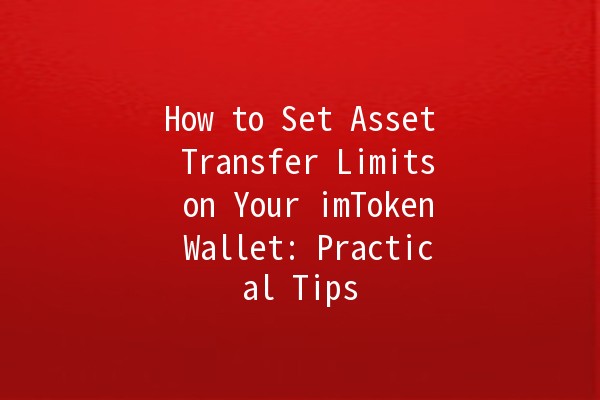Managing your digital assets securely is paramount, especially when using wallets like imToken. Setting asset transfer limits can help safeguard your investments from potential risks, such as unauthorized transactions. This article will detail practical tips and techniques for effectively establishing asset transfer limits in your imToken wallet, ensuring that your crypto assets remain protected.
Before diving into the setup process, it’s crucial to grasp what asset transfer limits are. Simply put, these limits restrict the amount of cryptocurrency that can be transferred out of your wallet within a specified period. This feature is beneficial for several reasons:
To begin, open your imToken wallet application. On the main screen, navigate to the “Settings” menu. This section houses various security and account management options, including the ability to set transfer limits.

Example: If you are using an Android device, tap on the gear icon located in the upper right corner. For iOS, it may be located within the profile menu.
Once you have accessed your settings, look for the “Security” or “Transfer Limits” option. Here, you will find the feature dedicated to setting asset transfer limits. Activate this feature by toggling it to the “ON” position.
Example: Upon toggling the option, a prompt may appear to guide you through the setup process or to confirm your choice.
Next, you will need to define your asset transfer limit. This process typically involves specifying the maximum amount of cryptocurrency you are allowed to send out daily, weekly, or monthly.
Example: If you want to restrict your daily transfer amount to 0.5 ETH, enter that value into the corresponding field. Take time to think about your usual transaction volume to make an informed choice.
In addition to defining the transfer limit, you must select the time frame for these limits. Options usually include daily, weekly, or monthly limits. Choose the timeframe that aligns best with your transaction habits.
Example: Setting a weekly limit might be beneficial if you tend to make occasional larger transactions rather than daily smaller ones.
After you have defined your limits and specified the time frame, ensure you confirm and save your settings. This step is critical to activate the transfer limits.
Example: Once you click the “Save” button, a confirmation message should indicate that your settings have been successfully updated.
After setting your asset transfer limits, it's essential to review them periodically. As your investment strategy evolves or your transactional habits change, adjusting these limits may be necessary.
Tip: Set a reminder to review your limits every three months.
Keeping an eye on market trends may influence how you set your limits. For instance, if you anticipate significant market movements, adjusting your limits can help you capitalize on opportunities or protect against downturns.
Tip: Use market analysis tools or apps to track market changes and adjust your transfer limits accordingly.
Utilizing twofactor authentication adds an extra layer of security to your wallet. Even if your transfer limits are set, 2FA ensures that only authorized devices can initiate transactions.
Tip: Enable 2FA through an app like Google Authenticator or Authy for enhanced protection.
Familiarizing yourself with common security threats in the crypto space can help you make informed decisions regarding your asset transfer limits. Regularly educate yourself about potential scams, phishing attacks, and wallet vulnerabilities.
Tip: Follow reputable cryptocurrency news sources and forums to stay informed.
When dealing with new or lesserknown tokens, consider setting lower transfer limits until you’re confident in their security and market stability. This approach minimizes the risk associated with sudden market fluctuations or potential scams.
Tip: Conduct thorough research on any new cryptocurrencies before raising your transfer limits.
Exceeding your transfer limit results in a failed transaction, and you will need to either wait until the limit resets or adjust your settings. This safeguard ensures you stay within your designed limits.
Most wallets allow for different transfer limits based on the asset type. Check your imToken wallet settings to see if this feature is available, as having distinct limits can provide tailored security for each cryptocurrency.
If you find that transactions are consistently failing, check your transfer limit settings. Ensure they align with your transaction habits. Adjust if necessary, and monitor for smooth transaction processing.
Generally, setting transfer limits does not incur any fees; however, be mindful of standard transaction fees associated with cryptocurrency transfers. Check imToken’s fee structure for further information.
Yes, you can modify your transfer limits through the settings menu at any time. Simply follow the steps outlined above to adjust your limits as needed.
It’s advisable not to share your personal transfer limits or wallet information with anyone. Doing so can expose you to security risks and unauthorized transactions. Always keep your wallet information confidential.
By following these tips and techniques for setting asset transfer limits on imToken, you can significantly enhance the security of your digital assets. The implementation of transfer limits, accompanied by diligent monitoring and regular reviews, will ensure your cryptocurrency investments remain secure and under your control.